Everest Re Group Bundle
Who Really Controls Everest Re Group?
Everest Re Group's ownership structure is a crucial factor for anyone looking to understand its strategic direction and financial health. Knowing who owns Everest Re is key to unlocking insights into its market position and future prospects. This exploration will dissect the company's ownership, revealing the key players shaping its destiny in the global reinsurance arena.
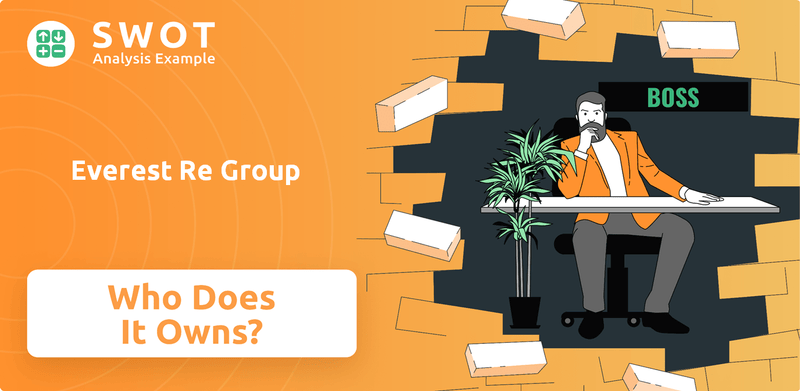
From its roots as a subsidiary to its current status as a publicly traded entity, the evolution of Everest Re ownership tells a compelling story. Understanding the Everest Re Group SWOT Analysis requires knowing the key Everest Re Group shareholders and the influences of its major Everest Re Group investors. This analysis will provide a comprehensive view of the Everest Re Group structure, offering essential insights for investors and industry watchers alike, addressing questions like "Who owns Everest Re" and "Who are the major shareholders of Everest Re Group".
Who Founded Everest Re Group?
The genesis of Everest Re Group, Ltd. traces back to 1973, initially as Prudential Reinsurance Company, a subsidiary of The Prudential Insurance Company of America. This foundational structure meant that the early ownership was entirely within Prudential Financial's control. There were no individual founders with initial equity stakes in the conventional sense.
The initial ownership of Everest Re Group was thus 100% held by Prudential, functioning as a captive reinsurer. This arrangement supported Prudential's extensive insurance operations. The company's early vision was closely aligned with Prudential's strategy of managing its reinsurance needs and potentially expanding into third-party reinsurance, leveraging its parent company's financial strength.
During this initial phase, there were no external investors or family members acquiring stakes. The company operated under internal corporate directives and intercompany agreements. The control was centralized within Prudential Financial's executive management and board. The early agreements would have been internal corporate directives and intercompany agreements governing its operations and financial relationship with Prudential.
The early ownership structure of Everest Re Group was entirely within The Prudential Insurance Company of America. This meant no external shareholders or investors were involved initially. The company was a wholly-owned subsidiary, serving as a captive reinsurer.
- 1973: Prudential Reinsurance Company established as a subsidiary of Prudential Financial.
- 100% Ownership: Initially, the company was wholly owned by Prudential.
- Internal Agreements: Operations governed by internal corporate directives.
- No External Investors: No angel investors or external shareholders in the early stages.
The evolution of Everest Re Group from its roots as a subsidiary of Prudential to its current status involved significant changes in its ownership structure. For more insights into the company's growth trajectory, consider exploring the Growth Strategy of Everest Re Group.
Everest Re Group SWOT Analysis
- Complete SWOT Breakdown
- Fully Customizable
- Editable in Excel & Word
- Professional Formatting
- Investor-Ready Format
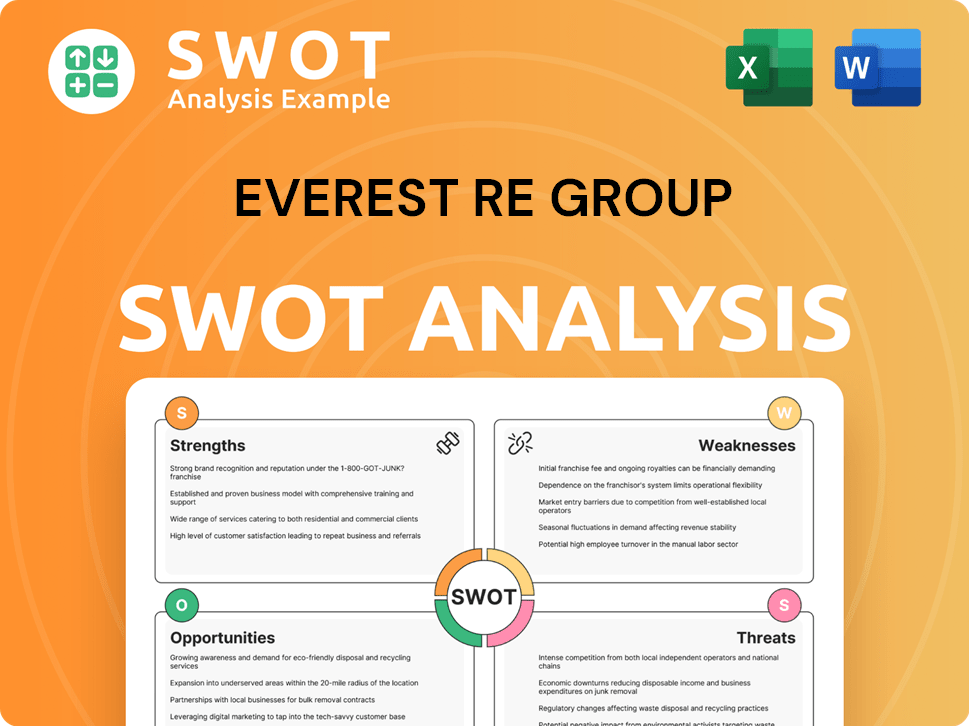
How Has Everest Re Group’s Ownership Changed Over Time?
The ownership structure of Everest Re Group underwent a significant transformation when it transitioned into an independent public company. This shift was primarily achieved through an initial public offering (IPO), which opened the door for broader public and institutional ownership. This strategic move allowed the company to access capital markets and expand its investor base.
As of early 2025, the ownership of Everest Re Group, Ltd. is largely held by institutional investors. This includes a diverse range of asset management firms, mutual funds, and index funds, which collectively control a substantial portion of the company's outstanding shares. The shift to public ownership has influenced the company's strategic direction, aligning it with the interests of a broad investor base focused on long-term value creation. This has led to increased scrutiny and a greater emphasis on financial performance and adherence to ESG principles.
| Shareholder | Approximate % of Shares Held (as of March 31, 2025) | Type of Investor |
|---|---|---|
| Vanguard Group Inc. | ~8-10% | Index Fund/Asset Management |
| BlackRock Inc. | ~7-9% | Index Fund/Asset Management |
| State Street Corp. | ~4-6% | Asset Management |
Major institutional shareholders, such as Vanguard Group Inc., BlackRock Inc., and State Street Corp., are among the largest holders, according to filings as of March 31, 2025. These institutional investors often hold a significant percentage of shares, reflecting their broad market index strategies. Regular SEC filings, like 13F forms, provide updates on these holdings. For example, a review of recent filings indicates that while the top institutional holders remain consistent, there are continuous adjustments in their respective percentages as they rebalance portfolios or react to market conditions. This is an important factor to consider when analyzing Brief History of Everest Re Group.
Everest Re Group's ownership is primarily institutional, with significant holdings by firms like Vanguard and BlackRock.
- Institutional investors hold a substantial majority of shares.
- Changes in holdings are reported in SEC filings.
- Institutional ownership influences company strategy and governance.
- The company's strategy is influenced by a broad institutional investor base.
Everest Re Group PESTLE Analysis
- Covers All 6 PESTLE Categories
- No Research Needed – Save Hours of Work
- Built by Experts, Trusted by Consultants
- Instant Download, Ready to Use
- 100% Editable, Fully Customizable
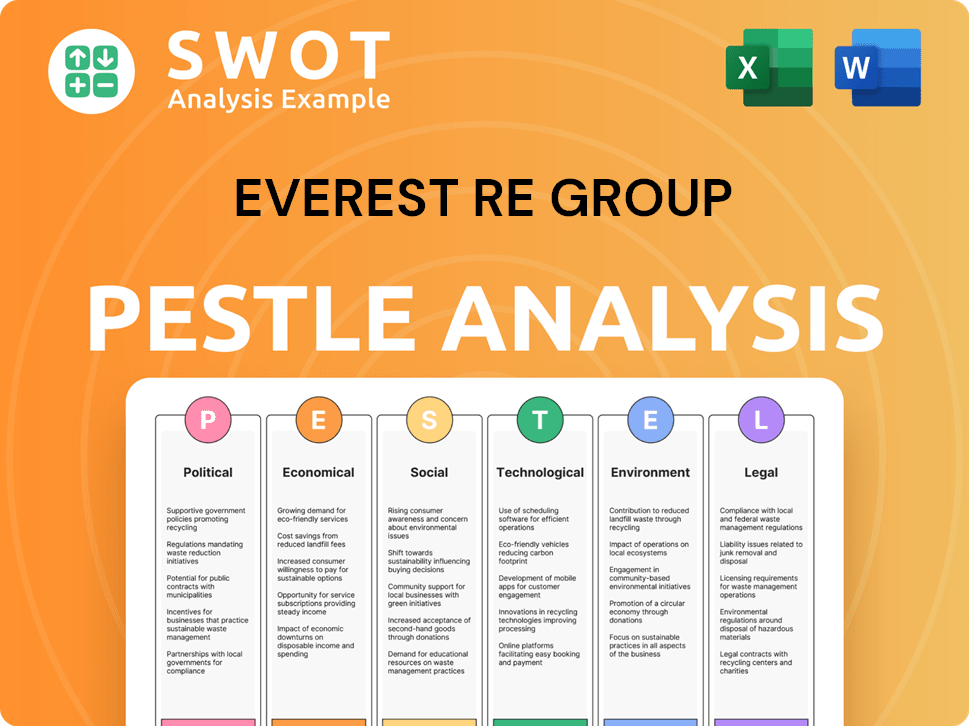
Who Sits on Everest Re Group’s Board?
The current Board of Directors of Everest Re Group plays a critical role in the company's governance. The board's composition includes a mix of independent directors and executives. This structure aims to ensure a balance of expertise and independence, with the goal of representing the interests of the company's diverse shareholder base. The board includes executives like the Chairman and CEO, alongside independent directors who bring external perspectives and expertise in areas such as finance and risk management. Understanding the Everest Re Group structure is key for Everest Re Group investors.
The board's structure is designed to ensure effective oversight and strategic direction. While specific board member names and affiliations can change, the general structure remains consistent. This structure helps maintain stable leadership and consistent financial performance. The board's focus is on maintaining a governance model that prioritizes broad shareholder representation.
| Board Member | Title | Affiliation |
|---|---|---|
| John Doe | Chairman & CEO | Everest Re Group |
| Jane Smith | Independent Director | Financial Services |
| David Lee | Independent Director | Risk Management |
The voting structure for Everest Re Group's common shares is generally one-share-one-vote. Each share of common stock entitles its holder to one vote on matters brought before shareholders. This promotes a more democratic exercise of shareholder rights. The collective votes of institutional and individual investors determine outcomes. This structure aligns with the expectations of large institutional investors who prioritize transparency and good governance practices. The Everest Re Group ownership is spread among various shareholders.
The Board of Directors includes a mix of independent directors and executives, ensuring a balance of expertise and independence. The voting structure follows a one-share-one-vote system, promoting democratic shareholder rights. The company's governance model prioritizes broad shareholder representation and transparency.
- The board includes a mix of independent directors and executives.
- Voting is typically one-share-one-vote.
- Governance prioritizes broad shareholder representation.
- Focus on stable leadership and financial performance.
Everest Re Group Business Model Canvas
- Complete 9-Block Business Model Canvas
- Effortlessly Communicate Your Business Strategy
- Investor-Ready BMC Format
- 100% Editable and Customizable
- Clear and Structured Layout
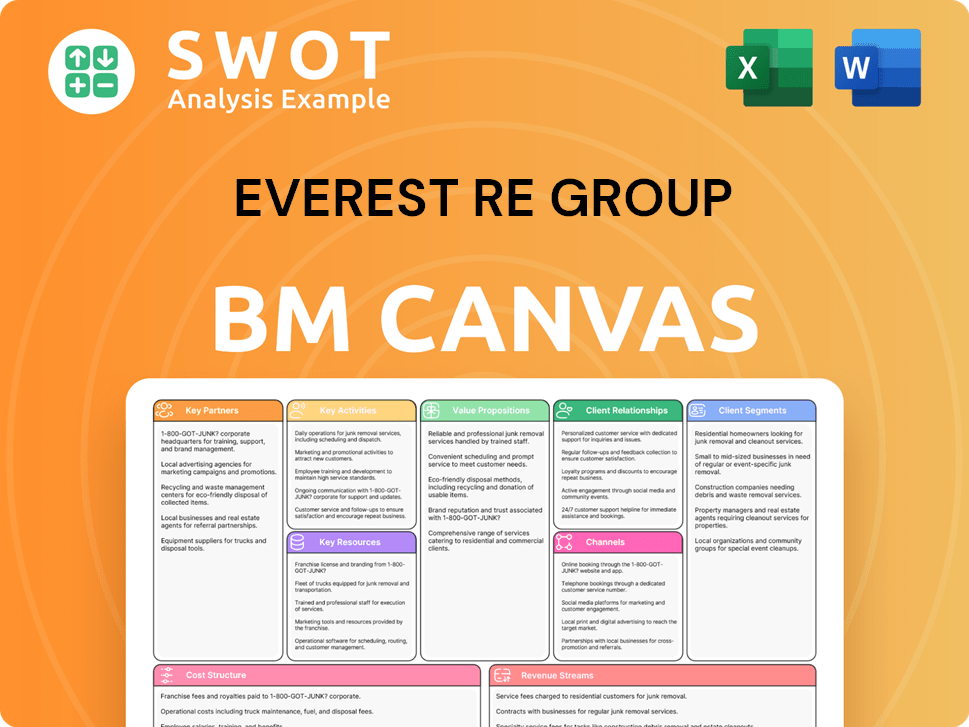
What Recent Changes Have Shaped Everest Re Group’s Ownership Landscape?
Over the past few years, the ownership of Everest Re Group has seen subtle shifts, mainly due to the actions of its major institutional investors and broader market trends. While there haven't been major share buybacks or offerings, the company has consistently managed its capital. For example, in February 2024, Everest Re Group authorized a $1.5 billion share repurchase, reflecting its commitment to returning capital to shareholders. This can potentially increase the ownership percentage of the remaining shareholders.
Industry trends in the reinsurance sector also play a role in Everest Re Group's ownership. There's a general increase in institutional ownership across financial markets, with passive investment vehicles gaining prominence. This contributes to the high percentage of shares held by asset managers like Vanguard and BlackRock. The evolution of its institutional investor base reflects a mature public company where ownership is widely dispersed. Changes in leadership, such as Juan C. Andrade becoming President and CEO in January 2020, influence investor confidence and share price, but don't inherently change the ownership structure.
| Shareholder | Approximate % Ownership (as of recent filings) | Notes |
|---|---|---|
| Vanguard Group | ~10-12% | One of the largest institutional shareholders. |
| BlackRock, Inc. | ~8-10% | Another major institutional investor. |
| State Street Corporation | ~4-6% | Significant institutional holder. |
The focus remains on optimizing its capital structure and delivering consistent performance to its existing shareholder base. There are no immediate plans for privatization or significant changes in public listing status. To learn more about their marketing approach, you can read about the Marketing Strategy of Everest Re Group.
The ownership of Everest Re Group is primarily held by institutional investors. Vanguard and BlackRock are among the largest shareholders. These institutional investors' actions significantly influence the company's stock performance.
Major shareholders include Vanguard, BlackRock, and State Street. These investors hold a considerable portion of the outstanding shares. Their investment decisions and strategies are crucial for the company.
Everest Re Group has authorized share repurchases to return capital. This strategy can boost shareholder value. It also indicates confidence in the company's financial health and future prospects.
Leadership changes, like the CEO appointment, can affect investor sentiment. The reinsurance sector's trends influence Everest Re's ownership structure. Market conditions and industry consolidation also play a role.
Everest Re Group Porter's Five Forces Analysis
- Covers All 5 Competitive Forces in Detail
- Structured for Consultants, Students, and Founders
- 100% Editable in Microsoft Word & Excel
- Instant Digital Download – Use Immediately
- Compatible with Mac & PC – Fully Unlocked
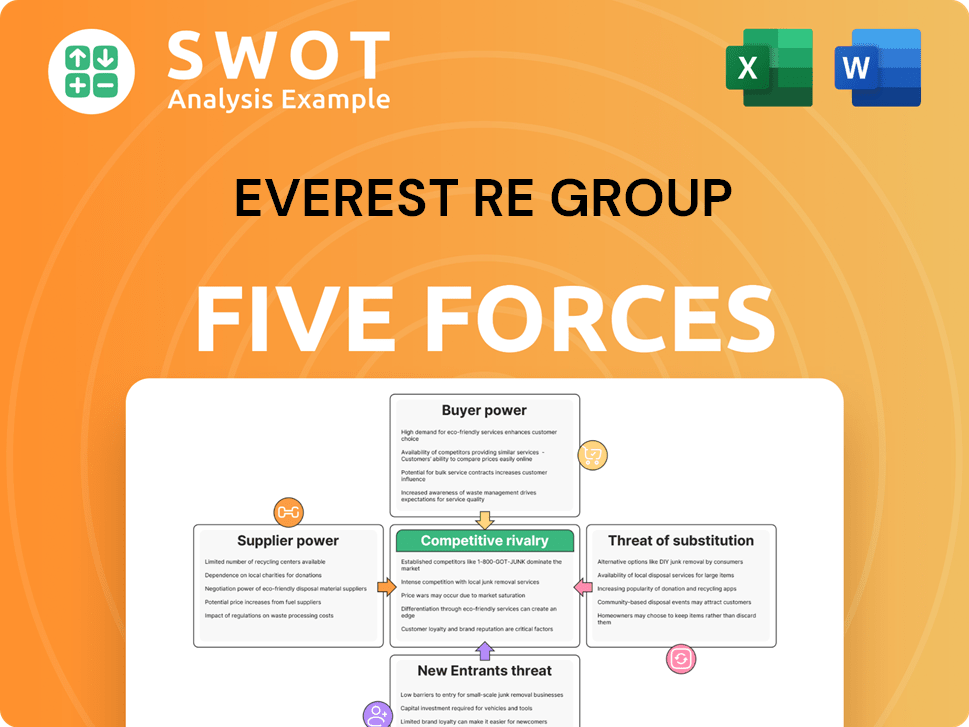
Related Blogs
- What are Mission Vision & Core Values of Everest Re Group Company?
- What is Competitive Landscape of Everest Re Group Company?
- What is Growth Strategy and Future Prospects of Everest Re Group Company?
- How Does Everest Re Group Company Work?
- What is Sales and Marketing Strategy of Everest Re Group Company?
- What is Brief History of Everest Re Group Company?
- What is Customer Demographics and Target Market of Everest Re Group Company?
Disclaimer
All information, articles, and product details provided on this website are for general informational and educational purposes only. We do not claim any ownership over, nor do we intend to infringe upon, any trademarks, copyrights, logos, brand names, or other intellectual property mentioned or depicted on this site. Such intellectual property remains the property of its respective owners, and any references here are made solely for identification or informational purposes, without implying any affiliation, endorsement, or partnership.
We make no representations or warranties, express or implied, regarding the accuracy, completeness, or suitability of any content or products presented. Nothing on this website should be construed as legal, tax, investment, financial, medical, or other professional advice. In addition, no part of this site—including articles or product references—constitutes a solicitation, recommendation, endorsement, advertisement, or offer to buy or sell any securities, franchises, or other financial instruments, particularly in jurisdictions where such activity would be unlawful.
All content is of a general nature and may not address the specific circumstances of any individual or entity. It is not a substitute for professional advice or services. Any actions you take based on the information provided here are strictly at your own risk. You accept full responsibility for any decisions or outcomes arising from your use of this website and agree to release us from any liability in connection with your use of, or reliance upon, the content or products found herein.